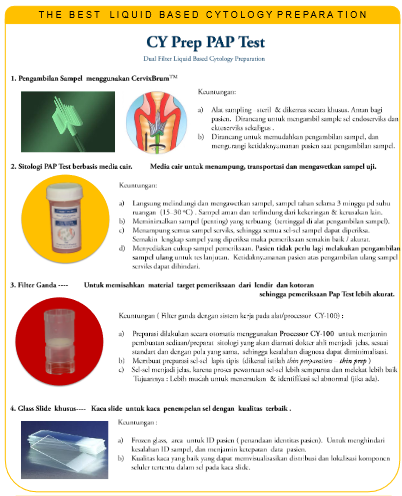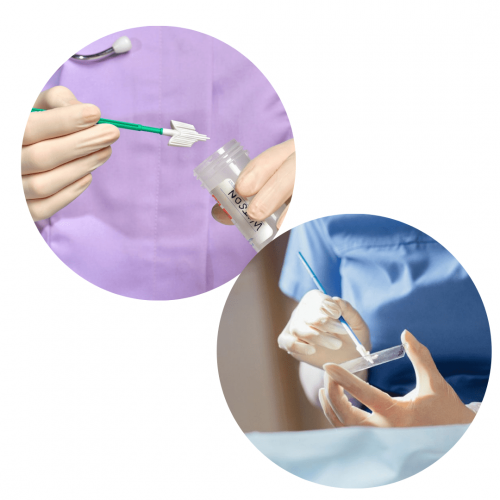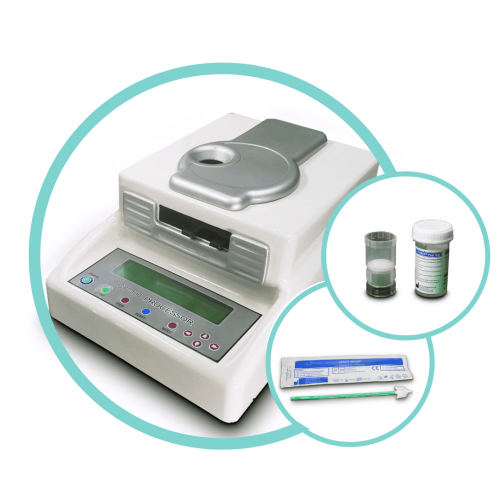Cervical cancer or commonly known as cervical cancer is one of the most common types of cancer in women.
In Indonesia, cervical cancer cases rank second after breast cancer as the most common type of cancer out of all cancer cases in women in 2020. There were more than 36,000 cases and 21,000 deaths from cervical cancer.
Cervical cancer is cancer that grows in the cervix, generally begins with the development of abnormal cells into cancer cells, and only shows symptoms that women complain about when they have entered an advanced stage. Cervical cancer can be detected early for treatment, and is reported to be almost 100% preventable if detected in early precancerous lesions and treated promptly.
Therefore it is important to detect cervical pre-cancer early before it develops into cervical cancer.
The main cause
Human Papillomavirus infection (HPV High Risk - high-risk type) is the cause. This virus can be transmitted through sexual contact. Viral infections cause changes in normal cells into abnormal cells that can develop cancer cells in the cervix (mouth of the womb).
How high is the chance of survival for cervical cancer patients?
With treatment, the 5-year survival rate for cervical cancer is:
- Stage 1: 80–93%
- Stage 2: 58–63%
- Stage 3: 32–35%
- Stage 4: 16%
At stage O (pre-cancerous), early detection of pre-cancerous lesions has almost 100% treatment success. Therefore, early detection of cervical cancer becomes a very important examination for women.
Cervical Cancer Risk Factor
- Long-term use of hormonal contraceptive pills. Taking birth control pills for more than 5 years can be one of the causes of cervical cancer
- The behavior of multiple sex partners. The more people who have had sexual relations with you or your partner, the greater the chance of getting infected with the HPV virus
- Have had sex at an early age. In women at a very young age, the structure of the reproductive organs, including the cervix, is more susceptible to HPV infection
Prevention
There are several preventive steps that a woman can take:
- Avoid having sex with more than one partner (multiple partners)
- Having sex safely using a condom
- Doing HPV vaccination to increase immunity / reduce the risk of being infected with high-risk HPV
- Pap test / Pap Smear periodically to detect the growth of abnormal cells that develop into cancer cells in the combination Pap Test and DNA examination of the Human Papilloma Virus (HPV DNA Test) is recommended for adult women who had sexual activity
- Healthy lifestyle and no smoking
Cervical Cancer Symptoms
- In the early stages, cervical cancer usually does not show symptoms because abnormal cells that develop into cancer cells do not always cause discomfort/pain complaints.
- Abnormal vaginal bleeding, including spots, is a common symptom of cervical cancer. It usually occurs after sex, outside of menstruation, or after menopause.
- In addition to abnormal bleeding, other symptoms that may appear are non-stop discharge from the vagina with a strange or different odor than usual, pink, pale, brown, or bloody, pain during sexual intercourse, and changes in the menstrual cycle. without a known cause, such as menstruation that lasts more than 7 days for 3 months or more, or heavy bleeding.
Early Examination / Cervical Cancer Screening
- Pap smear test. The method of detecting cervical cancer cytology was found by George Papanicolaou (1883-1962). The screening method is a pre-cancerous cytology examination by taking a small number of cervical surface cells, to be examined under a microscope to detect abnormal cells that have the potential to develop into cervical cancer cells. At this time technology has developed with the preparation of Pap Tests using the LBC (Liquid-based cytology) method of cervical cytology. LBC method is the best method in cervical cytology examination
- HPV DNA Test. Is a molecular biological examination to detect the presence of the high-risk type of Human Papilloma Virus (HPV).
- The IVA test is the simplest way to observe (visually) changes in the morphology of the cervical surface with the use of acetic acid. Acetic Acid Visual Inspection
Pap Test service preparation methods available in the Laboratory
There are two types of Pap smear cytological preparation methods, the conventional Pap smear, and the LBC Pap Test (Liquid Based Cytology) method. The conventional Pap Smear method has been proven to be successful in preventing cervical cancer, an early examination method that was discovered by Papanicolaou since 1920, detects abnormal cells in pre-cervical cancer lesions so that treatment at the pre-cancerous stage can prevent cervical cancer. However, the Pap Smear method (conventional) still has its limitations, including in the handling of the sample to be examined, the presence of dirt and mucus that hinders microscopic examination/observation of cells, and often the thickness of the cell layer in the resulting cytological preparations creates problems that risk negative results. fake from conventional pap smears.
The development of research results and application of technology has succeeded in developing improvements to Pap test preparation, namely the LBC (Liquid Based Cytology) Pap Test method. The advantages of cytological preparation of Pap test LBC method include:
- Almost 100% of test samples can be checked
- Standard preparation procedure, easy, fast, and uniform results
- Preparation results: cells are clearly visible & a thin layer increases the accuracy in detecting abnormal cells
- Distraction from the presence of mucus, blood, and fecal debris is removed
- Samples available for confirmatory tests (HPV DNA test, Chlamydia test/ Gonorrhea)
PT Isotekindo Intertama is a distributor of the CY-PREP ™ CY-100 Processor, a cervical pre-cancer cytology product using the accurate LBC method. CY-PREP ™ CY-100 Processor products are as follows:
- Sampling using CY-PREP™ Pap Test CERVIX-BRUM ®
Benefit:
1. The sampling device is sterile, specially packaged it safe for the patient, and designed to take samples of both endo and ectocervical at the same time.
2. Designed to simplify sampling and reduce sampling inconvenience - Liquid media to contain, transport, and preserve test samples using CY-PREP™ Pap Test Preservation Solution
Benefit:
1. Protect the sample, hold for 3 weeks at room temperature (15-30 °C). Samples are safe from dryness & damage
2. Minimizes the risk of important samples being left in the sampling device
3. Collect all cervical samples so that all sample cells can be examined
4. Provide enough test samples so that the patient does not need to re-samples for follow-up tests - Separating the inspection target material from lenders and dirt using a dual filterBenefit:
1. Make a thin layer of preparation
2. Cells become clearer when examined because the cell staining process becomes more perfect and adheres better - Glass slide for sample attachment using IHC link glass slide
Benefit:
1. Make a thin layer of preparation
2. Cells become clearer when examined because the cell staining process becomes more perfect and adheres better

Reference:
- Journal of Mid-Life Health. Comparative study between pap smear and visual inspection with acetic acid (via) in the screening of CIN and early cervical cancer.
- Johnson, T. WebMD (2020). Cervical Cancer.
- Mayo Clinic (2021). Diseases & Conditions. Cervical Cancer.
- National Health Service (2018). Health A to Z. Cervical Cancer.
- World Health Organization (2017). Cervical Cancer Screening and Management of Cervical Pre-Cancers.
- Insert Pack CY-PREP ™ CY-100 Processor.







